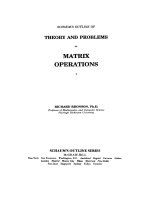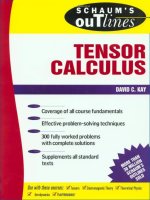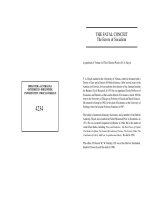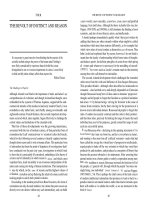schaum s easy outline of principles of economics based on schaum s outline of theory and problems of principl phần 1 pot
Bạn đang xem bản rút gọn của tài liệu. Xem và tải ngay bản đầy đủ của tài liệu tại đây (413.34 KB, 16 trang )
SCHAUM’S Easy OUTLINES
P
RINCIPLES OF
E
CONOMICS
Other Books in Schaum’s
Easy Outlines Series Include:
Schaum’s Easy Outline: Calculus
Schaum’s Easy Outline: College Algebra
Schaum’s Easy Outline: College Mathematics
Schaum’s Easy Outline: Discrete Mathematics
Schaum’s Easy Outline: Differential Equations
Schaum’s Easy Outline: Elementary Algebra
Schaum’s Easy Outline: Geometry
Schaum’s Easy Outline: Linear Algebra
Schaum’s Easy Outline: Mathematical Handbook
of Formulas and Tables
Schaum’s Easy Outline: Precalculus
Schaum’s Easy Outline: Probability and Statistics
Schaum’s Easy Outline: Statistics
Schaum’s Easy Outline: Trigonometry
Schaum’s Easy Outline: Business Statistics
Schaum’s Easy Outline: Principles of Accounting
Schaum’s Easy Outline: Applied Physics
Schaum’s Easy Outline: Biology
Schaum’s Easy Outline: Biochemistry
Schaum’s Easy Outline: Molecular and Cell Biology
Schaum’s Easy Outline: College Chemistry
Schaum’s Easy Outline: Genetics
Schaum’s Easy Outline: Human Anatomy
and Physiology
Schaum’s Easy Outline: Organic Chemistry
Schaum’s Easy Outline: Physics
Schaum’s Easy Outline: Programming with C++
Schaum’s Easy Outline: Programming with Java
Schaum’s Easy Outline: Basic Electricity
Schaum’s Easy Outline: Electromagnetics
Schaum’s Easy Outline: Introduction to Psychology
Schaum’s Easy Outline: French
Schaum’s Easy Outline: German
Schaum’s Easy Outline: Spanish
Schaum’s Easy Outline: Writing and Grammar
SCHAUM’S Easy OUTLINES
P
RINCIPLES OF
E
CONOMICS
Based on Schaum’s
Outline of Theory and Problems of
Principles of Economics (Second Edition)
by Dominick Salvatore, Ph.D.
and
Eugene A. Diulio, Ph.D.
Abridgement Editor
W m. Alan Bartley, Ph.D.
SCHAUM’S OUTLINE SERIES
McGRAW-HILL
New York Chicago San Francisco Lisbon London Madrid
Mexico City Milan New Delhi San Juan
Seoul Singapore Sydney Toronto
Copyright © 2003 by The McGraw-Hill Companies, Inc. All rights reserved. Manufactured in the United States of
America. Except as permitted under the United States Copyright Act of 1976, no part of this publication may be repro-
duced or distributed in any form or by any means, or stored in a database or retrieval system, without the prior writ-
ten permission of the publisher.
0-07-142583-7
The material in this eBook also appears in the print version of this title: 0-07-139873-2
All trademarks are trademarks of their respective owners. Rather than put a trademark symbol after every occur-
rence of a trademarked name, we use names in an editorial fashion only, and to the benefit of the trademark owner,
with no intention of infringement of the trademark. Where such designations appear in this book, they have been
printed with initial caps.
McGraw-Hill eBooks are available at special quantity discounts to use as premiums and sales promotions, or for
use in corporate training programs. For more information, please contact George Hoare, Special Sales, at
or (212) 904-4069.
TERMS OF USE
This is a copyrighted work and The McGraw-Hill Companies, Inc. (“McGraw-Hill”) and its licensors reserve all
rights in and to the work. Use of this work is subject to these terms. Except as permitted under the Copyright Act
of 1976 and the right to store and retrieve one copy of the work, you may not decompile, disassemble, reverse engi-
neer, reproduce, modify, create derivative works based upon, transmit, distribute, disseminate, sell, publish or sub-
license the work or any part of it without McGraw-Hill’s prior consent. You may use the work for your own non-
commercial and personal use; any other use of the work is strictly prohibited. Your right to use the work may be
terminated if you fail to comply with these terms.
THE WORK IS PROVIDED “AS IS”. McGRAW-HILL AND ITS LICENSORS MAKE NO GUARANTEES OR
WARRANTIES AS TO THE ACCURACY, ADEQUACY OR COMPLETENESS OF OR RESULTS TO BE
OBTAINED FROM USING THE WORK, INCLUDING ANY INFORMATION THAT CAN BE ACCESSED
THROUGH THE WORK VIA HYPERLINK OR OTHERWISE, AND EXPRESSLY DISCLAIM ANY WAR-
RANTY, EXPRESS OR IMPLIED, INCLUDING BUT NOT LIMITED TO IMPLIED WARRANTIES OF MER-
CHANTABILITY OR FITNESS FOR A PARTICULAR PURPOSE. McGraw-Hill and its licensors do not warrant
or guarantee that the functions contained in the work will meet your requirements or that its operation will be unin-
terrupted or error free. Neither McGraw-Hill nor its licensors shall be liable to you or anyone else for any inaccu-
racy, error or omission, regardless of cause, in the work or for any damages resulting therefrom. McGraw-Hill has
no responsibility for the content of any information accessed through the work. Under no circumstances shall
McGraw-Hill and/or its licensors be liable for any indirect, incidental, special, punitive, consequential or similar
damages that result from the use of or inability to use the work, even if any of them has been advised of the possi-
bility of such damages. This limitation of liability shall apply to any claim or cause whatsoever whether such claim
or cause arises in contract, tort or otherwise.
DOI: 10.1036/007145837
Contents
v
Chapter 1 Introduction to Economics 1
Chapter 2 Demand, Supply, and Equilibrium 13
Chapter 3 Unemployment, Inflation, and
National Income 25
Chapter 4 Consumption, Investment,
Net Exports, and Government
Expenditures 37
Chapter 5 Traditional Keynesian Approach
to Equilibrium Output 46
Chapter 6 Fiscal Policy 56
Chapter 7 The Federal Reserve and Monetary
Policy 64
Chapter 8 Monetary Policy and Fiscal Policy 74
Chapter 9 Economic Growth and Productivity 81
Chapter 10 International Trade and Finance 88
Chapter 11 Theory of Consumer Demand
and Utility 96
Chapter 12 Production Costs 104
Chapter 13 Perfect Competition 111
Chapter 14 Monopoly 118
Chapter 15 Monopolistic Competition and
Oligopoly 125
Chapter 16 Demand for Economic Resources 132
Chapter 17 Pricing of Wages, Rent, Interest,
and Profits 139
Index 149
For more information about this title, click here.
Copyright 2003 by The McGraw-Hill Companies, Inc. Click Here for Terms of Use.
This page intentionally left blank.
Chapter 1
Introduction
to Economics
In the chapter:
✔ Methodology of Economics
✔ Problem of Scarcity
✔ Production-Possibility Frontier
✔ Principle of Increasing Costs
✔ Scarcity and the Market System
✔ True or False Questions
✔ Solved Problems
Methodology of Economics
Economics is a social science that studies individu-
als and organizations engaged in the production, dis-
tribution, and consumption of goods and services.
The goal is to predict economic occurrences and to
develop policies that might prevent or correct such
problems as unemployment, inflation, or waste in the
economy.
Economics is subdivided into macroeconomics
and microeconomics. Macroeconomics studies ag-
gregate output, employment, and the general price level. Microeconom-
1
Copyright 2003 by The McGraw-Hill Companies, Inc. Click Here for Terms of Use.
ics studies the economic behavior of individual decision makers such as
consumers, resource owners, and business firms.
The discipline of economics has developed principles, theories, and
models that isolate the most important determinants of economic events.
In constructing a model, economists make assumptions to eliminate un-
necessary detail to reduce the complexity of economic behavior. Once
modeled, economic behavior may be presented as a relationship between
dependent and independent variables. The behavior being explained is
the dependent variable; the economic events explaining that behavior are
the independent variables. The dependent variable may be presented as
depending upon one independent variable, with the influence of the oth-
er independent variables held constant (the ceteris paribus assumption).
An economic model will also specify whether the dependent and inde-
pendent variables are positively or negatively related, i.e., moving in the
same or opposite directions.
Note!
Ceteris paribus is Latin for “other things being
equal.” This phrase is used often by economists in
modeling to isolate the relationship between spe-
cific dependent and independent variables.
Example 1.1
We shall assume that the amount a consumer spends (C) is positively re-
lated to her disposable income (Y
d
), i.e., C = f(Y
d
). Table 1.1 presents data
on consumer spending for five individuals with different levels of in-
come. As seen in the table, consumption and disposable income display
a positive relationship.
The data from Table 1.1 are plotted in Figure 1-1 and labeled C
1
. The
dependent variable, consumer spending, is plotted on the vertical axis and
the independent variable, disposable income, is plotted on the horizontal
axis. Graphs are used to present data and the positive or negative rela-
tionship of the dependent and independent variables visually.
2 PRINCIPLES OF ECONOMICS
Problem of Scarcity
Economics is the study of scarcity—the study of the allocation of scarce
resources to satisfy human wants. People’s material wants, for the most
part, are unlimited. Output, on the other hand, is limited by the state of
CHAPTER 1: Introduction to Economics
3
Table 1.1
(in $)
Figure 1-1
technology and the quantity and quality of the economy’s resources.
Thus, the production of each good and service involves a cost. A good is
usually defined as a physical item such as a car or a hamburger, and a ser-
vice is something provided to you such as insurance or a haircut.
Scarcity is a fundamental problem for every society. Decisions must
be made regarding what to produce, how to produce it, and for whom to
produce. What to produce involves decisions about the kinds and quanti-
ties of goods and services to produce. How to produce requires decisions
about what techniques to use and how economic resources (or factors of
production) are to be combined in producing output. The economic re-
sources used to produce goods and services include:
• Land. The economy’s natural resources—such as land, trees,
and minerals.
• Labor. The mental and physical skills of individuals in a soci-
ety.
• Capital. Goods—such as tools, machines, and factories—used
in production or to facilitate production.
The for whom to produce involves decisions on the distribution of output
among members of a society.
Remember
Economics helps to solve the three
important questions of what to pro-
duce, how to produce it, and for
whom to produce.
These decisions involve opportunity costs. An opportunity cost is
what is sacrificed to implement an alternative action, i.e., what is given
up to produce or obtain a particular good or service. For example, the op-
portunity cost of expanding a country’s military arsenal is the decreased
production of nonmilitary goods and services. Opportunity costs are
found in every situation in which scarcity necessitates decision making.
Opportunity cost is the value—monetary or otherwise—of the next
4 PRINCIPLES OF ECONOMICS
best alternative, or that which is given up. This concept is used in both
macroeconomics and microeconomics.
Production-Possibility Frontier
A production-possibility frontier shows the maximum number of alter-
native combinations of goods and services that a society can produce at
a given time when there is full utilization of economic resources and tech-
nology. Table 1.2 presents alternative combinations of guns and butter
output for a hypothetical economy (guns represent the output of military
goods, while butter represents nonmilitary goods and services). In choos-
ing what to produce, decision makers have a choice of producing, for ex-
ample, alternative C—5,000 guns and 14 million units of butter—or any
other alternative presented.
This production-possibility schedule is plotted in Figure 1-2. The
curve, labeled PP, is called the production-possibility frontier. Point C
plots the combination of 5,000 guns and 14 million units of butter, as-
suming full employment of the economy’s resources and full use of its
technology, as do all of the alternatives presented in Table 1.2.
The production-possibility frontier depicts not only limited produc-
tive capability and therefore the problem of scarcity, but also the concept
of opportunity cost. When an economy is situated on the production-
possibility frontier, such as at point C, gun production can be increased
only by decreasing butter output. Thus, to move from alternative C (5,000
guns and 14 million units of butter) to alternative D (9,000 guns and 6
million units of butter), the opportunity cost of the additional 4,000 units
of gun production is the 8 million less units of butter that are produced.
CHAPTER 1: Introduction to Economics 5
Table 1.2
The production-possibility frontier shifts outward over time as more
resources become available and/or technology is improved. Growth in an
economy’s productive capability is depicted in Figure 1-2 by the outward
shift of the production-possibility frontier from PP to P′P′. Suppose a so-
ciety chooses to be at point C. When the production-possibility frontier
shifts outward, 4,000 additional guns can be produced without sacrific-
ing any butter production, as seen at C′. This example should not be con-
strued as a refutation of the law of opportunity cost just because fewer
sacrifices may be made when growth occurs. When there is full utiliza-
tion of resources and an absence of growth, additional gun production is
possible only when the output of butter is decreased.
Points on a production-possibility frontier are considered to be effi-
cient. Points within the frontier are inefficient, and points outside the
frontier are unattainable. Points C and D are efficient because all avail-
able resources are utilized and there is full use of existing technology. Po-
sitions outside the production-possibility frontier are unattainable since
the frontier defines the maximum amount that can be produced at a giv-
en time. Positions within the frontier are inefficient because some re-
sources are either unemployed or underemployed.
6 PRINCIPLES OF ECONOMICS
Figure 1-2
Principle of Increasing Costs
Resources are not equally efficient in the production of all goods and ser-
vices, i.e., they are not equally productive when used to produce an al-
ternative good. This imperfect substitutability of resources is due to dif-
ferences in the skills of labor and to the specialized function of most
machinery and many buildings. Thus, when the decision is made to pro-
duce more guns and less butter, the new resources allocated to the pro-
duction of guns are usually less productive. It therefore follows that as
larger amounts of resources are transferred from the production of butter
to the production of guns, increasing units of butter are given up for few-
er incremental units of guns. This increasing opportunity cost of gun pro-
duction illustrates the principle of increasing costs.
Note!
The principle of increasing opportunity cost is the
reason why the production-possibility frontier is
bowed outward from the origin of the graph, and
not a straight line.
Scarcity and the Market System
As we have seen, two of the most important economic decisions faced by
a society are deciding what goods and services to produce and how to al-
locate resources among their competing uses. The combination of goods
and services produced can be resolved by government command or
through a market system. In a command economy, a central planning
board determines the mix of output. The experience with this system,
however, has not been very successful, as evidenced by the changing eco-
nomic and political events in the 1990s in the command economies of
Eastern Europe and the former USSR.
In a market economy, economic decisions are decentralized and are
made by the collective wisdom of the marketplace, i.e., prices resolve the
three fundamental economic questions of what, how, and for whom. The
CHAPTER 1: Introduction to Economics
7
only goods and services produced are those that individuals are willing
to purchase at a price sufficient to cover the cost of producing them. Be-
cause resources are scarce, goods and services are produced using the
technique and resource combination that minimizes the cost of produc-
tion. And the goods and services produced are sold (distributed) to those
who are willing and have the money to pay the prices.
Most countries have a mixed economy, a mixture of both command
and market economies. For example, the United States has primarily a
market economy, although the government produces some goods, such
as roads, and finances these expenditures by taxing the income of indi-
viduals and businesses. The government may also regulate how the mar-
ket operates, such as with minimum wage laws.
True or False Questions
1. Economic models and theories are accurate statements of reality.
2. In the statement “consumption is a function of disposable in-
come,” consumption is the dependent variable.
3. Graphs provide a visual representation of the relationship between
two variables.
4. A production-possibility frontier depicts the unlimited wants of a
society.
5. When there is full employment, the decision to produce more of
one good necessitates decreased production of another good.
6. There are increasing costs of production because economic re-
sources are not equally efficient in the production of all goods and ser-
vices.
Answers: 1. False; 2. True; 3. True; 4. False; 5. True; 6. True
Solved Problems
Solved Problem 1.1 What are some of the problems associated with the
study of economics?
Solution: Multiple difficulties may arise with the study of economics.
a. Generalizing from individual experiences often leads to wrong
conclusions (this is called the fallacy of composition). For example, an
8 PRINCIPLES OF ECONOMICS
individual becomes richer by increasing his savings, but society as a
whole may become poorer if everyone saves because people may be put
out of work.
b. The fact that one economic event precedes another does not nec-
essarily imply cause and effect, which is what economists want to study.
For example, the U.S. stock market collapse in 1929 did not cause the
worldwide Great Depression of the 1930s.
c. Since economics is a social science and laboratory experiments
cannot be conducted, economic theories can only describe expected be-
havior. Thus, these theories are not as precise or reliable as the natural
laws established in the pure sciences.
Solved Problem 1.2
a. The demand for purchasing videos might be presented as a func-
tion of the video’s purchase price. Does this mean that income and the
cost of renting a video are unimportant?
b. What is the meaning of and the economist’s use of the term ceteris
paribus?
Solution:
a. To further simplify the demand-for-videos function—Q
videos
=
f (Y
d
, P
videos
, P
rental
)—we could assume that the individual’s disposable
income and the cost of renting videos are unchanged. Thus, while income
and rental cost do influence the demand for videos, here more videos are
purchased only because of a lower price.
b. The phrase ceteris paribus means that other independent variables
affecting the dependent variable are held constant, or are unchanged.
When other independent variables that influence the quantity of videos
purchased are held constant, the demand for videos can be presented as
Q
videos
= f (P
videos
), ceteris paribus.
Solved Problem 1.3 Suppose an economy has the production-possibili-
ty frontier depicted in Figure 1-3?
a. What implication does the selection of point A or C have regard-
ing the economy’s current and future production of consumer goods and
services?
b. What linkage is there between saving and economic growth?
CHAPTER 1: Introduction to Economics
9









